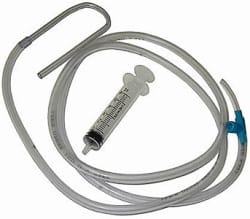You just bought your first fish or coral and need to acclimate it to your saltwater aquarium or quarantine tank. Please remember that less than a month ago your fish may have been swimming in the ocean. Then a diver captured it and spent the next week acclimating it to changes in water pressure to prevent toxic shock. Then the fish was loaded on a boat and brought to the collection facility. There it is placed in a holding tank. When a wholesaler places an order, the fish is then packaged in a bag and shipped across the ocean. There it sits at the wholesaler until a smaller wholesaler or retailer places an order and the fish is bagged and shipped across the country. Eventually the fish arrives at your local fish store and in your tank. This is quite a journey and it is amazing that any fish survives. Please take the time to properly acclimate your new fish to prevent stress.
Drip Acclimation
1. You will need Airline Hose and a Ball Valve. These materials can be purchased separately or as an Acclimation Kit.
2. Turn off your aquarium lights for the rest of the day. This will reduce the stress of your new fish and make your current livestock less aggressive towards the new fish.
3. Float your new fish or coral for at least 10 minutes to acclimate the fish to your aquarium’s water temperature. An appropriate temperature is 74-82 degrees.
4. Carefully cut open the bag and pour the fish into a small container. If you are rough with the fish, it is more likely to become stressed and die or develop disease.

5. Take the airline hose and attach it to a ball valve so you can control the water flow.
6. Start a siphon so that water drips into the bucket, it should be about 1 drop per second. This method is best used for sensitive fish, coral, clams and other invertebrates.
7. Continue to drip for one to two hours and until the salinity and pH in the container matches the salinity and pH in your aquarium.
8. Drain out some of the water and catch the fish in a net and place it into the aquarium. Do not add any of the acclimation water back into the aquarium, as it may contain pests or parasites from the fish store. Some hobbyists prefer to hand catch their fish, but some fish, like the lionfish are venomous and should not be hand caught.
Scoop Fish Acclimation
1. Turn off your aquarium lights for the rest of the day. This will reduce the stress of your new fish and make your current livestock less aggressive towards the new fish.
2. Float your new fish or coral for at least 10 minutes to acclimate the fish to your aquarium’s water temperature. An appropriate temperature is 76-84 degrees.
3. Carefully open cut open the bag and pour the fish into a small container. If you are rough with the fish, it is more likely to become stressed and die or show disease.
4. Take approximately one cup of your aquarium water and add it into the bucket.
5. Wait 10-15 minutes and remove 1 cup of water from the acclimation container and replace it with 1 cup of aquarium water.
6. Repeat this step every 10-15 minutes for at least one hour and until the salinity and pH in the container matches the salinity and pH in your aquarium.
7. Drain out some of the water and catch the fish in a net and place it into the aquarium. Do not add any of the acclimation water back into the aquarium, as it may contain pests or parasites from the fish store. Some hobbyists prefer to hand catch their fish, but fish like lionfish are venomous and should not be hand caught.
Coral Acclimation
Many fish stores and coral owners do not even know that they have pests or parasites. If you have not been treating your corals, you are most likely infected with flatworms or something worse. Treating with ReVive Coral Cleaner and Tropic Marin Pro Coral Cure can help prevent red flatworms, brown planaria, acropora eating flatworms, zoanthid eating nudibranchs, little red bugs, sundial snails, sea spiders and montipora eating nudibranchs.
